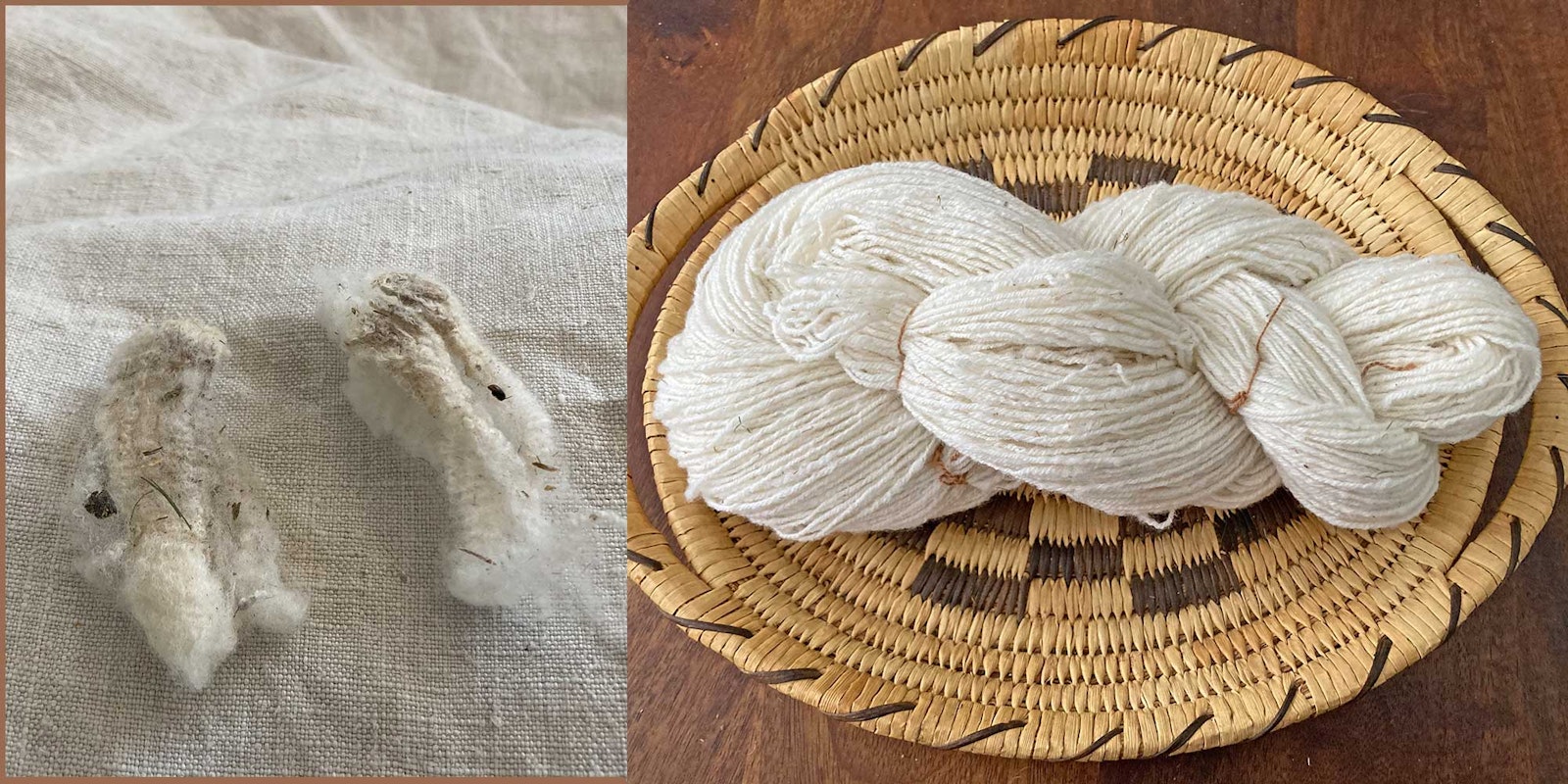When I get fleeces for teaching, they often have sections that are particularly dirty or full of vegetable matter (VM). While I don’t bring this less-than-ideal fleece to the classroom, I often spin it for personal use. This reminds me of much of the fleece I used in my first decade of spinning when I had little access to good fleece, using whatever I could get my hands on.
VM is seen by many spinners, especially those accustomed to commercial preparations, as a deal breaker. I don’t see it that way. There are things we can do to deal with VM during the processing and spinning stages, and to be frank, I don’t mind some flecks of VM in a finished yarn.
The traditional gold standard for hand-processing fleece to reduce VM is, of course, wool combs. I did not have wool combs for much of my spinning life, and I spent years tackling high-VM fleeces with my handcards. I developed my own approach using the fleeces I had and the tools that were within reach. Now, I own wool combs and use them when I want a combed preparation, but I still prefer spinning from a carded prep and still rely on my handcards. Not every spinner has or needs combs, and I think there are ways to prepare and spin heavy-VM wool to get a great yarn without them.
 Devin rewashed the somewhat-sticky Targhee, which makes processing easier and allows more VM to fall out during processing.
Devin rewashed the somewhat-sticky Targhee, which makes processing easier and allows more VM to fall out during processing.
The Case of the Chaffy Targhee
Recently, I pulled out a double handful of Targhee fleece from my stash of not-good-enough-for-teaching-but-good-enough-to-spin wool. I wanted to make a hat using something soft and lofty, and I thought that Targhee would be a good choice. This fleece had dirty tips that remained even after washing, and parts of it had fairly large amounts of VM: hay, chaff, and some seeds. I knew I wanted to spin with a supported longdraw technique using carded rolags, so I set out to card the wool.
The first thing I noticed was that it felt greasy and somewhat stiff, even though it had felt clean when I washed it several years ago. Some spinners I know refer to this as the grease “rising,” and I like that term. Often with finewools, an initial wash will seem to be fully effective, only for more grease to seemingly appear from nowhere. So, I decided to do a second, lighter wash. After it was fully dry, the fleece was delightfully soft, though still full of VM.
Carding does not extract VM from fiber the way combing does, but it does open the fiber, letting some VM fall out. How much will fall out has a lot to do with the wool type and VM type. When I started carding my heavy-VM Targhee fleece, I worked over a white lap cloth to show the amount of VM that can fall out during this step. This photo shows about a third of the fleece I used for my hat.
 Devin’s lap cloth collected a significant amount of VM in the form of chaff and neps after just one rolag.
Devin’s lap cloth collected a significant amount of VM in the form of chaff and neps after just one rolag.
Once carded, the rolags still had very apparent VM, but some of that would be dealt with during spinning. I choose to spin heavy-VM wool as a very fine single, which lets much of the VM simply fall out during spinning. Most of the rest can be dealt with by a flick of a fingernail or a quick rub of pinched fingers along the yarn. When I started spinning, I again worked over a lap cloth and here is the VM that fell out of a single rolag.
 Chaff and neps captured on Devin’s lap cloth while spinning just one rolag!
Chaff and neps captured on Devin’s lap cloth while spinning just one rolag!
Plying will remove some VM as well, as the yarn passing through your fingers will dislodge some bits of VM, too. The finished yarn—400 yards of three-ply—still shows some VM, but it does not feel harsh or prickly, and at this point, almost all the VM is locked down in the twist and does not stick out. A section of fleece that at first glance would seem too full of VM to be used is now a skein of yarn destined to be used and worn.
 The finished three-ply yarn still has a small amount of VM present, but Devin isn’t bothered. More VM will fall out during knitting, and the resulting skein will be useful, warm, and well-loved.
The finished three-ply yarn still has a small amount of VM present, but Devin isn’t bothered. More VM will fall out during knitting, and the resulting skein will be useful, warm, and well-loved.
Devin’s tips for dealing with VM without combs:
Make sure your fleece is fully clean; greasy fleece will not release as much VM.
Wear an apron or use a lap cloth—this will be messy.
Spin a fine single, and if you need a larger yarn, ply up.
Spin using a draw that lets twist into the drafting triangle. I find that often the twist will flick the VM out.
Use a fingernail or a quick smoothing gesture with pinched fingertips along the yarn to remove bits of VM that are sticking out of the single.
Learn more about Devin’s approach to making useful cloth at SOAR 2023 in Loveland, Colorado.
Devin Helmen has been immersed in fiber since learning to spin at age eight. They spin, knit, and weave in beautiful Minnesota. Devin enjoys writing and teaching about fiber arts and has a passion for spindles and everyday textiles. They blog, intermittently, at www.afewgreenfigs.blogspot.com.

